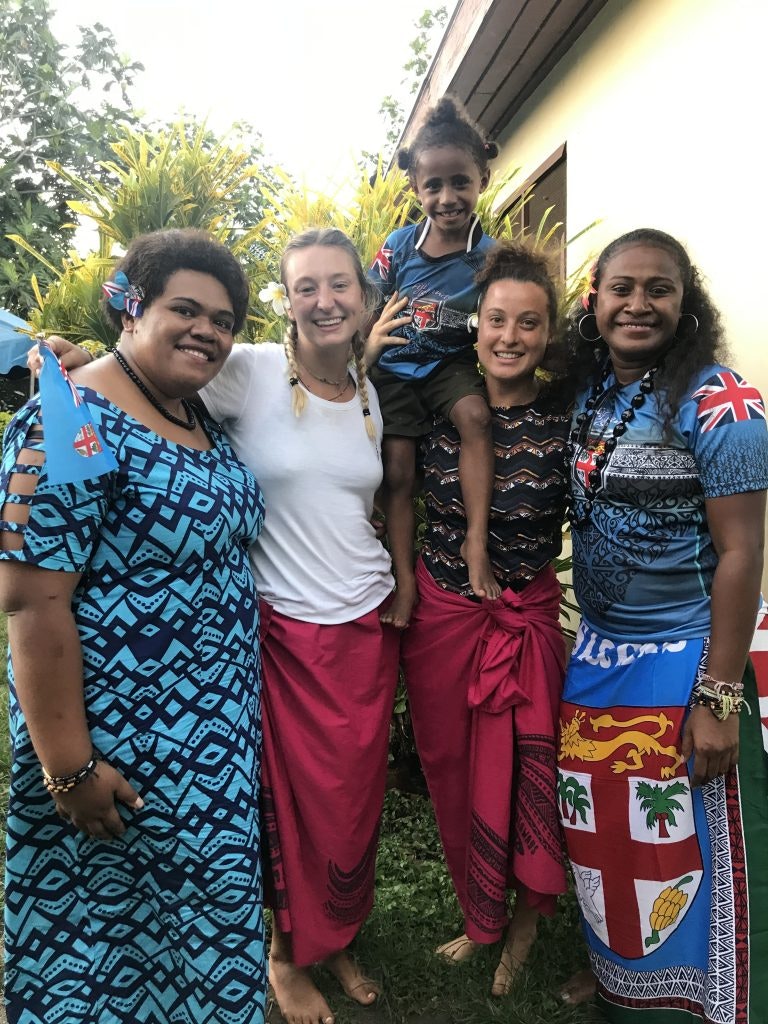It only took a one-week trip to Central America to ignite Anna Quinn’s passion for languages. Back when she was in seventh grade, she was mad when her parents signed her up for Spanish class. Then they booked a Rustic-type trip for her to Honduras. During that program, Quinn saw the immense benefits of speaking another language.
“After just a week there I was hooked,” Quinn said. “I needed to speak Spanish to better communicate with all the new friends I made. I also needed a reason to convince my family to let me go back. And it worked.”
Quinn threw herself into her language studies and ended up traveling to Honduras eight times. She also studied abroad for two semesters in Spanish-speaking countries.

Anna Quinn (center) enjoys meeting new people and working on her language skills in the countries she visits.
To date, Quinn has now visited 34 countries, and lived in four – the United States, Dominican Republic, Spain, and Costa Rica. She also has traveled to 38 states in the U.S. and serves as a Global Program Advisor for Rustic Pathways. Along the way, she has become such a strong Spanish speaker that she is often asked if she is from Argentina.
Her pathway to learning another language is not uncommon. Travel is the best way to become versed in a second language. However, it can be a big jump to go from a classroom to an immersive experience in another country. Here are some tips on how students can make the most of the opportunity:
Use engaging entertainment to spark interest – Before traveling, students can use some of their favorite entertainment to start thinking in another language. This may include movies, TV shows, and even video games.
Watching a favorite movie with audio dubbing in a foreign language is a good start. When you know what the dialogue says in English, you may start to pick up a few conversational words in another language.
There also is the option of watching TV shows in another language and even changing the language selection for some video games.
Set your expectations – Students should be ready for it to be challenging – no matter how much classroom learning they’ve had. When immersed in another culture, it can be surprising how much you feel like a beginner even if you’ve had a few years of language learning.
It helps to be patient and hang in there. Practice makes it easier to listen and respond on the fly in a real world setting.
Look for opportunities on the road – Being able to say “What is this?” or “What is this called?” can be a good way to jump start a conversation with someone. You’ll show them you’re curious, and give them the opportunity to be the expert and share some of their language or culture.

Rustic students often get a chance to converse in another language during their service projects. Copyright: © 2016 Rustic Pathways
Expect Language Variations – Common phrases that are used in each country will vary, so students will need to be flexible and remember the greetings they learned in language class may not work as well in some regions.
In Costa Rica, “pura vida” is a response for pretty much anything. In the Dominican Republic, “pana” is friend instead of “amigo,” so you’ll hear, “mi pana” instead of “mi amigo.” Or “Qué lo qué?” is “what’s up,” but literally translates to “what the what.” “Primo” means cousin, but is often used when talking to a stranger.
These are just a few of the differences, but it won’t take long for students to adjust if they ask for translation help when they need it.
Be prepared to lesson swap – Sometimes you’ll find someone – even a child or teen – who wants to practice speaking English. If you’re helpful, they may be willing to also have a conversation in their native language to make it a win-win learning experience.
Be respectful – Look for people who appear open to chatting with you. If someone doesn’t seem ready to engage in conversation, politely step back. Not everyone is willing or able to be your teacher or language buddy.
Keep a language journal – Seeing something written down may help your memory, so you can write down phrases, words, or ideas that you’ve learned. Writing in another language also engages more senses that may help when trying to speak.
Don’t give up – Even when you struggle to find the right words, language does not need to be a barrier. Students who travel with Rustic Pathways are often amazed how they can communicate with gestures and body language. DeAndra Forde is among those who found this when she traveled with Rustic Pathways to Costa Rica and the Dominican Republic.
“Although my Spanish at the time was intermediate-basic, that didn’t matter,” Forde said. “Everyone on that program was able to connect, and it just further showed me that a language barrier isn’t a barrier to create fruitful and impactful relationships.”
To get started on a language journey, look for immersive travel programs that allow interaction with local community members. That will beat tourist-oriented itineraries where English is more frequently spoken. For more information, visit our program page. There you will find programs in countries where the languages spoken range from Spanish to Thai. ¡Buena suerte!
